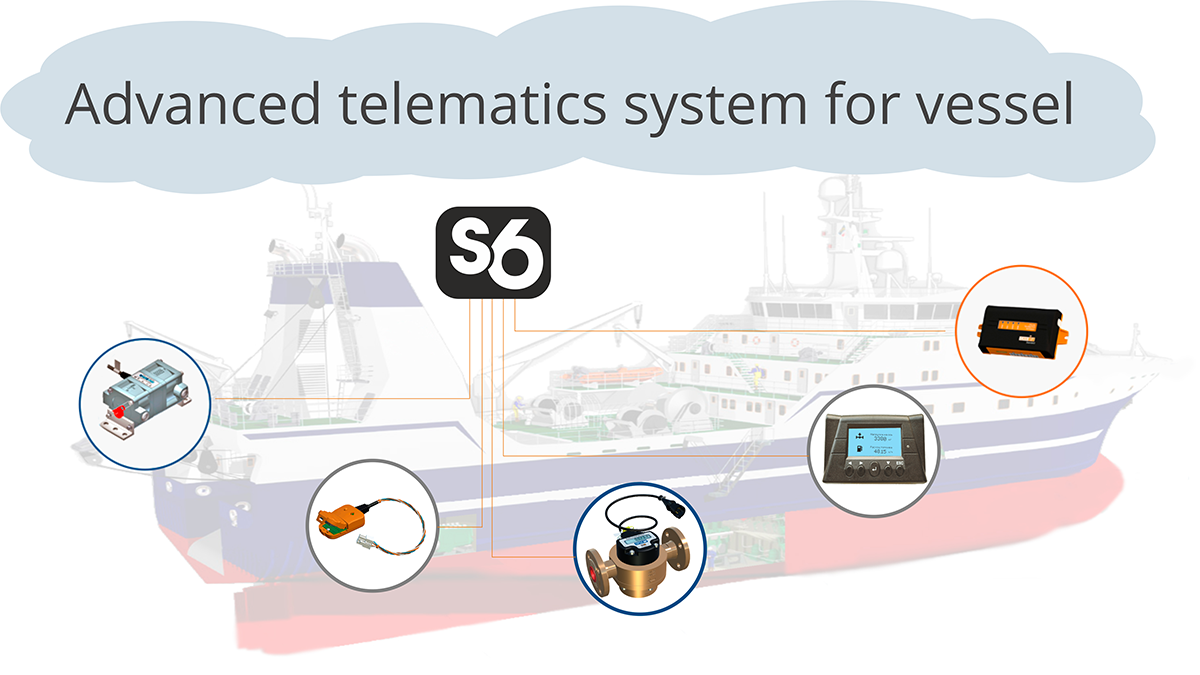Vessel — is a complex machinery, that is difficult to monitor performance of. Many ships and boats have several engines, diesel generators, boilers, fuel tanks, cranes, mechanisms and other equipment.
Optimizing vessel operating costs requires gathering a large amount of data — operating parameters of units and systems of the vessel. To obtain data like this, you have to build an advanced telematics system, which provides collecting parameters from a variety of standard and additional sensors, as well as receiving information from onboard digital interfaces.
Also, creating an equipment network composed of telematics unit, additional sensors and standard onboard devices is a complexity typical for deployment of water transport telematics system.
Advantages of S6 Technology
- Allows connecting over 100 fuel level sensors, flow meters, contactless CAN bus readers of engines and diesel power-generators, RS converters etc. within one object.
- Reliable cabling system with common power supply line for all connected units.
- Fast and easy connection of all telematics equipment using bus principle.
- Simple integration of analog sensors and devices with different interfaces into telematics system.
- Easy configuration of telematics server – different interfaces and types of messages are unified into a single CAN J1939/S6 protocol format.
- Only one CAN interface is needed for gathering over 200 operating parameters.
- Scalability of telematics system: easy connection of additional onboard equipment.
- High resistance to interference and incorrect electrical connection of equipment.
Hardware for vessel monitoring system
Multiple sensors, measuring devices and standard equipment are combined into a single wired network based on S6 Technology:
- Fuel flow meters in various models for accurate measurement of fuel consumption by each consumer:
DFM and DFM D fuel flow meters for small and medium-sized vessels with fuel consumption from 1 to 600 l/h. CAN j1939/S6 output interface allows monitoring 40+ Parameters of fuel consumption and engine operating time.
DFM Marine flow meters for heavy machinery for flow rates up to 4,000 L/h. Measuring chamber and flow meter’s body is made of brass – highly durable alloy, resistant to significant changes in temperature/humidity. There is also a model with a duralumin body. Output interfaces: RS232/RS485 (ASCII and Modbus), CAN j1939/S6 (+ NMEA 2000) and also normalized pulse.
DFM Industrial fuel flow meters – big flow meters for large ships with flow rates from 0,72 to 25 m3/h.Can be used for heavier grades of fuel (HFO heavy fuel oil or furnace oil) with kinematic viscosity up to 300 cSt.
Wireless DFM S7 fuel flow meters – new fuel flow meters with wireless data transfer over BLE (Bluetooth low energy). Data on fuel consumption is sent simultaneously to several devices: to GPS tracker, smartphone or tablet with Bluetooth.
- Fuel level sensors, which provide monitoring of tank refuelling and fuel draining.
- Contactless readers – for safe data reading from CAN and 1708 bus, integration of vehicle buses into telematics system.

- MasterCAN data converters – for reading data via Modbus RTU protocol, integration of standard equipment with different interfaces, combining data from two CAN buses, converting analog sensor signals and process automation.
- Display shows data received from all devices in the captain’s cabin.
- Telematics gateway (telematics unit) generates reports using received parameters and sends information over the Internet (2G, 3G, LTE) to a web-based software platform.
Process automation on vessel
Telematics system of a large vessel allows monitoring 200+ parameters of ship’s operation, and also implementing process automation.
Control automation of analog devices, lamps, relays is provided by MasterCAN DAC converter. CANUp telematics gateway (or other compatible CAN/S6 telematics unit) sends commands to converter via CAN j1939/S6 interface.
With the help of Technoton hardware you can control any analog devices depending on the characteristics of MasterCAN DAC converter, it is possible, for example, to automate pumping of liquid in a ballast tank, which is used to control crankiness of vessel. But one of the most prevalent vessel process automation tasks – is control of gensets aboard the ship. Let’s go through the solution, based on Technoton sensors and MasterCAN DAC converter, that allows ensuring uninterrupted fuel supply of vessel’s diesel generators.

Using data from fuel level sensor, converter sends control signal to switching relay of a fuel pump, which ensures fuel pumping from storage fuel tank to main feed tank of genset. After fuel level in the main feed tank of generator reaches a certain pre-defined value, MasterCAN DAC sends another control signal to switch off the pump.

